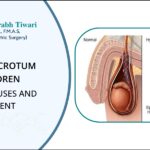Introduction
Hirschsprung disease, a rare but significant congenital disorder affecting the colon, has puzzled medical professionals and parents alike for decades. Among those dedicated to unraveling its mysteries is Dr. Saurabh Tiwari, a distinguished pediatric surgeon committed to shedding light on the main cause of this enigmatic condition.
Understanding Hirschsprung Disease
Hirschsprung disease is characterized by the absence of nerve cells in the colon’s wall, particularly in the lower part. These missing nerve cells, also known as ganglion cells, are crucial for the normal functioning of the bowel muscles, enabling the passage of stool. Without them, the affected segment of the colon becomes contracted and obstructed, leading to complications like chronic constipation, abdominal distension, and even life-threatening conditions if left untreated.
The Main Culprit: Neural Crest Development
At the heart of Hirschsprung disease lies an issue during embryonic development, specifically in the formation of neural crest cells. The neural crest is a group of cells that migrate during early embryonic development and give rise to various structures in the body, including the enteric nervous system, which controls bowel function.
In individuals with Hirschsprung disease, there is a failure of neural crest cells to migrate and populate the entire length of the colon. This results in a segment of the bowel lacking the essential ganglion cells needed for coordinated muscle contractions. The exact reasons behind this migration failure are still under investigation, but genetic factors play a pivotal role.
Genetic Factors
Research has identified a strong genetic component in the development of Hirschsprung disease. Mutations in specific genes associated with neural crest cell development and migration have been implicated in the disorder. The RET gene, in particular, has been extensively studied and is found to be mutated in a significant percentage of Hirschsprung cases.
Dr. Saurabh Tiwari and his colleagues are actively involved in genetic research related to Hirschsprung disease. By delving into the intricate details of the human genome, they aim to uncover the precise genetic variations that contribute to the disruption of neural crest cell migration. Identifying these genetic factors not only enhances our understanding of the disease but also opens doors for early detection and targeted interventions.
Clinical Presentation and Diagnosis
Hirschsprung disease often becomes apparent in the first few weeks of life, as affected infants struggle with constipation and fail to pass meconium, the first stool passed by a newborn. The diagnosis involves a combination of clinical evaluation, imaging studies, and, in some cases, genetic testing. Dr. Saurabh Tiwari emphasizes the importance of a multidisciplinary approach to accurately diagnose and manage Hirschsprung disease, involving pediatric surgeons, gastroenterologists, and geneticists working in tandem.
Conclusion
In The quest to unveil the mysteries of Hirschsprung disease, Dr. Saurabh Tiwari stands at the forefront of pediatric surgery and research. By focusing on the neural crest cell development and genetic factors underlying this condition, he and his team strive to pave the way for improved diagnostic methods, early intervention strategies, and, ultimately, better outcomes for children affected by this challenging congenital disorder. Through continued dedication and collaborative efforts, the medical community inches closer to comprehending the main cause of Hirschsprung disease and offering hope to families facing this intricate challenge.




